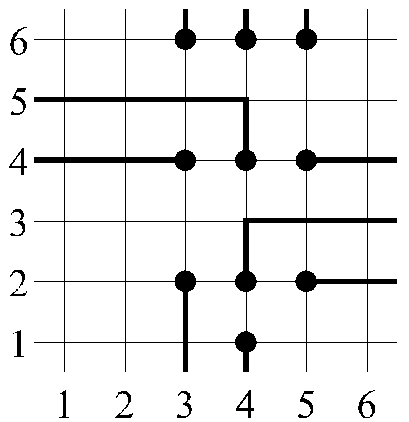Problem G : Crimewave
inputfile: G.IN
outputfile: G.OUT
Description
Nieuw Knollendam is a very modern town. This becomes
clear already when looking at the layout of its map, which is just a rectangular
grid of streets and avenues. Being an important trade centre, Nieuw Knollendam
also has a lot of banks. Almost on every crossing a bank is found (although
there are never two banks at the same crossing). Unfortunately this has attracted
a lot of criminals. Bank hold-ups are quite common, and often on one day
several banks are robbed. This has grown into a problem, not only to the
banks, but to the criminals as well. After robbing a bank the robber tries
to leave the town as soon as possible, most of the times chased at high speed
by the police. Sometimes two running criminals pass the same crossing, causing
several risks: collisions, crowds of police at one place and a larger risk
to be caught. To prevent these unpleasant situations the robbers agreed
to consult together. Every Saturday night they meet and make a schedule
for the week to come: who is going to rob which bank on which day? For every
day they try to plan the get-away routes, such that no two routes use the
same crossing. Sometimes they do not succeed in planning the routes according
to this condition, although they believe that such a planning should exist.
Problem
Given a grid of (s ( a) and the crossings
where the banks to be robbed are located, find out whether or not it is possible
to plan a get-away route from every robbed bank to the city-bounds, without
using a crossing more than once. Input
The first line of the input contains the number of problems p to be solved.
The first line of every problem contains the number s of streets (1 <= s <= 50) ,
followed by the number a of avenues (1 <= a <= 50) , followed by the number b
(b >= 1) of banks to be robbed.
Then b lines follow, each containing the location of a bank in the form of two numbers x
(the number of the street) and y (the number of the avenue). Evidently 1 <= x <= s and
1 <= y <= a .
Output
The output file consists of p lines. Each line contains the text
possible
or
not possible
. If it is possible to plan non-crossing get-away routes, this line should contain the word:
possible
. If this is not possible, the line should contain the words
not possible
.
Example
Sample input
2
6 6 10
4 1
3 2
4 2
5 2
3 4
4 4
5 4
3 6
4 6
5 6
5 5 5
3 2
2 3
3 3
4 3
3 4
Correct output for the sample input
possible
not possible


